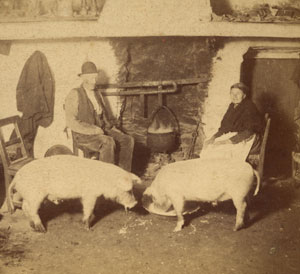Annotation:Pig in the Parlour: Difference between revisions
No edit summary |
No edit summary |
||
| Line 1: | Line 1: | ||
---------- | |||
{{TuneAnnotation | |||
|f_tune_annotation_title=https://tunearch.org/wiki/Annotation:Pig_in_the_Parlour > | |||
|f_annotation='''PIG IN THE PARLOUR'''. English, Reel or Country Dance Tune (cut time). F Major. Standard tuning (fiddle). AABB. The melody and country dance directions were first printed in London by music publisher John Walsh in his '''Second Book of the Compleat Country Dancing-Master''', 3rd edition (1735), and in later editions of the same volume. It was also printed by John Johnson in his '''Choice Collection of 200 Favourite Country Dances, vol. 3''' (1744) and by John Simpson in '''The Delightful Pocket Companion, vol. 2''' (c. 1750). London musician Thomas Hammersely entered it into his 1790 music manuscript collection (as "Pig in Ye Parlour"). | |||
---- | |||
---- | |||
'''PIG IN THE PARLOUR'''. English, Reel or Country Dance Tune (cut time). F Major. Standard tuning (fiddle). AABB. The melody and country dance directions were first printed in London by music publisher John Walsh in his '''Second Book of the Compleat Country Dancing-Master''', 3rd edition (1735), and in later editions of the same volume. It was also printed by John Johnson in his '''Choice Collection of 200 Favourite Country Dances, vol. 3''' (1744) and by John Simpson in '''The Delightful Pocket Companion, vol. 2''' (c. 1750). London musician Thomas Hammersely entered it into his 1790 music manuscript collection (as "Pig in Ye Parlour"). | |||
<br> | <br> | ||
<br> | <br> | ||
[[File:pigparlour.jpg|300px|thumb|left|]] | [[File:pigparlour.jpg|300px|thumb|left|]] | ||
"Pig in a Parlour" has long been an English metaphor for something out of place, and perhaps unwelcome. So too, if one puts a 'pig in a parlour', it is still a pig (i.e. context does not alter character). | "Pig in a Parlour" has long been an English metaphor for something out of place, and perhaps unwelcome. So too, if one puts a 'pig in a parlour', it is still a pig (i.e. context does not alter character). | ||
|f_source_for_notated_version= | |||
|f_printed_sources=Walsh ('''The Second Book of the Compleat Country Dancing-Master, 3rd edition'''), London, 1735; No. 14. | |||
|f_recorded_sources= | |||
|f_see_also_listing= | |||
}} | |||
------------- | |||
---- | |||
Latest revision as of 02:21, 11 October 2020
X:1 T:Pig in the Parlour M:C| L:1/8 B:John Walsh – The Second Book of the Compleat Country Dancing-Master (3rd edition) B: (London, 1735, No. 14, p. 8) N:Each strain twice Z:AK/Fiddler’s Companion K:F F2|AFEF AFEF|d2c4 BA|B2A2G2F2|EF G4 F2| AFEF AFEF|de f4 ed|e2 dc G2=B2|cGEG C2|| c2|ecBc ecBc|b2 a4 gf|e2d2c2B2|AG F4 c2| ecBc gcBc|ga b4 ag|afef gece|f2c2A2||
PIG IN THE PARLOUR. English, Reel or Country Dance Tune (cut time). F Major. Standard tuning (fiddle). AABB. The melody and country dance directions were first printed in London by music publisher John Walsh in his Second Book of the Compleat Country Dancing-Master, 3rd edition (1735), and in later editions of the same volume. It was also printed by John Johnson in his Choice Collection of 200 Favourite Country Dances, vol. 3 (1744) and by John Simpson in The Delightful Pocket Companion, vol. 2 (c. 1750). London musician Thomas Hammersely entered it into his 1790 music manuscript collection (as "Pig in Ye Parlour").

"Pig in a Parlour" has long been an English metaphor for something out of place, and perhaps unwelcome. So too, if one puts a 'pig in a parlour', it is still a pig (i.e. context does not alter character).

